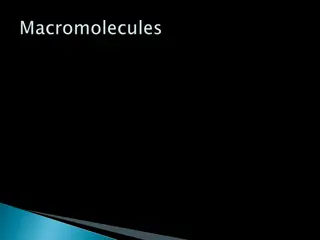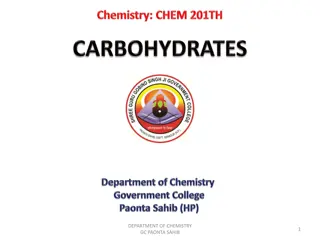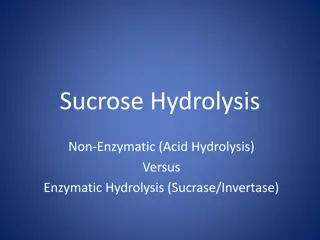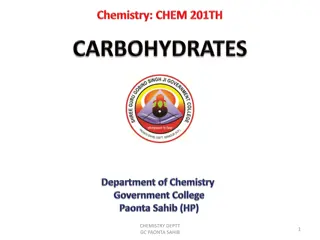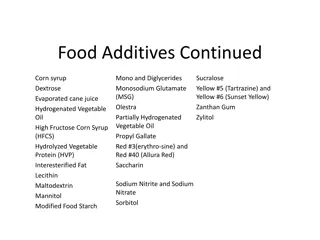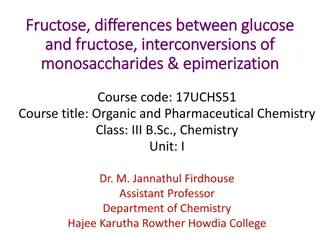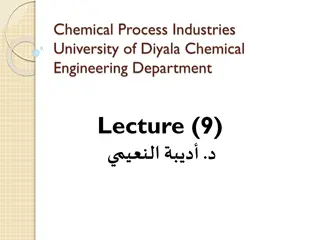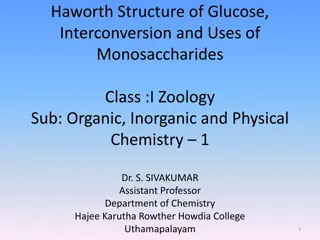Seliwanoff Color Reaction and its Significance
The Seliwanoff color reaction, discovered by Russian chemist Feodor Feodorovich Selivanov, is used to differentiate between aldoses and ketohexoses based on their dehydration and reaction with resorcinol in acidic conditions. Ketoses like fructose react faster than aldoses like glucose, leading to a
3 views • 20 slides
Osazone Test: A Chemical Test for Detecting Reducing Sugars
The Osazone test is a chemical test used to detect reducing sugars by forming derivatives of carbohydrates with phenyl hydrazine. This test helps in distinguishing different reducing sugars and differentiating between reducing and non-reducing sugars. The principle involves the reaction between carb
11 views • 22 slides
Carbohydrates in Living Organisms
Carbohydrates, along with proteins, lipids, and nucleic acids, are essential macromolecules in living organisms. They are made up of carbon, hydrogen, and oxygen in a 1:2:1 ratio. Carbohydrates provide the main energy source for living things, with examples including glucose, fructose, and sucrose.
0 views • 58 slides
Structural Insights into D-Fructose: Chemistry Department Findings
Exploring the structural aspects of D-fructose, this content delves into the open chain structure limitations, pyranose and furanose structures, ring size determination, and Haworth projection formulae. Discover how the cyclic hemiketal structures resolve the shortcomings of the open chain represent
0 views • 11 slides
Sucrose Hydrolysis and Reducing Sugars in Carbohydrate Chemistry
This content delves into the mechanisms of sucrose hydrolysis through non-enzymatic and enzymatic processes, highlighting disaccharides like sucrose, lactose, and maltose. It explores the significance of glycosidic bonds in carbohydrate structures and discusses the reducing capacity of sugars such a
7 views • 16 slides
Comprehensive Analysis of Fructose Ring Structures in Chemistry Department at GC Paonta Sahib
Explore the ring structures of D-(-)-fructose in the chemistry department at GC Paonta Sahib, including the limitations of the open-chain structure, pyranose and furanose structures, ring size determination, and Haworth projection formulae. Discover the complexities and intricacies of fructose isome
3 views • 11 slides
Common Food Additives: Corn Syrup, Dextrose, Evaporated Cane Juice, Hydrogenated Vegetable Oil
Explore the properties and uses of common food additives like corn syrup, dextrose, evaporated cane juice, and hydrogenated vegetable oil. Learn where these additives are found, their impact on health, and key facts to be aware of. Discover insights about weight gain concerns related to high fructos
0 views • 16 slides
Carbohydrates: Composition, Structure, and Function
Carbohydrates are composed of carbon, hydrogen, and oxygen in a specific ratio. Monosaccharides such as glucose, fructose, and galactose are carbohydrate monomers, while polysaccharides like lactose, sucrose, starch, cellulose, and glycogen are carbohydrate polymers. The chemical formula for glucose
0 views • 8 slides
All About Fructose: Properties, Preparations, and Chemical Reactions
Fructose, also known as fruit sugar, is a ketohexose naturally occurring in various sources. This article covers the differences between glucose and fructose, interconversions of monosaccharides, epimerization, preparation methods, physical properties, and chemical reactions of fructose. From its fo
0 views • 22 slides
Evolution of Sugar Production: a Historical Perspective
Sugar, a key commodity throughout history, has a rich background in human culture, trade, and technology. The journey of sugar from ancient India to the modern-day challenges of high fructose corn syrup in the United States reflects a dynamic industry shaped by advancements in refining technologies,
0 views • 15 slides
Uses and Conversions of Glucose and Fructose in Chemistry
Glucose and fructose have various uses, including as food for patients and in confectionery. Glucose is also used in silvering mirrors, processing tobacco, and starting material for vitamin C synthesis. Fructose is a sweetening agent and a sugar substitute. Glucose can be converted into fructose thr
0 views • 10 slides


